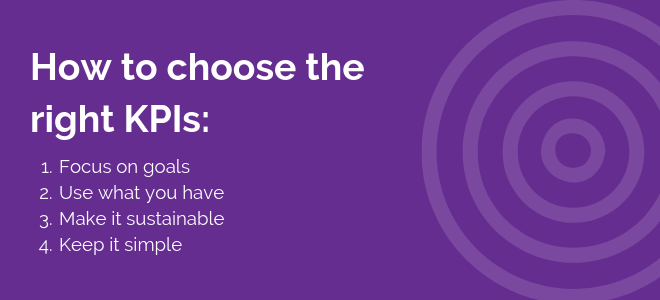In this blog, we'll be going through everything related to KPIs within field service management. Let's dive in.
|
What are the benefits of using KPIs? What are the benefits of KPIs for field workers? |
How do you choose the right KPIs |

How can a field service manager accurately monitor the performance of a mobile workforce? In the past, the answer was simple… you couldn’t.
But the move to digital management methods has transformed the way we're able to track and measure our mobile operations.
We now have the ability to easily access data on a whole range of different working processes.
To make effective use of this, however, you need to find the best ways of using this information - to identify the data that can help to increase the productivity of your mobile workforce.
This is exactly what KPIs (Key Performance Indicators) are designed to do. They’re a way to maximise the benefits of company information - to find smarter ways to gauge the performance and efficiency of your working processes.
What exactly is a KPI?
A Key Performance Indicator (KPI) refers to the use of business information to track and monitor the performance of an operation.
It could be something simple, such as tracking the time it takes for workers to complete a specific job. Or it can use more complex datasets, such as monitoring the percentage difference between planned and actual project costs.
What are the benefits of using KPIs?
The main reason for using KPIs is to gain a better understanding of how your mobile workforce is operating. It’s a way to improve your management visibility.

They provide particular benefits for mobile workforce managers because of the traditional challenges faced when trying to track and monitor teams of employees who are operating remotely.
Effective use of KPIs can allow managers to spot problems and identify trends that would otherwise have gone unnoticed.
What are the benefits of KPIs for field workers?
While KPIs are primarily used as a management tool, they do also provide significant benefits for a mobile workforce. With more accurate data, managers can make sure that realistic and achievable targets are set.
They can also incentivise and reward good performance. With access to accurate performance data, workers can be treated fairly and are judged on the basis of their performance and achievements.
How do you access performance data?
Every mobile service company gathers a basic amount of operational data - it’s what you need to get things done. This is the information that’s collected for work orders, delivery schedules and billing.
When these tasks are being handled via digital processes, the data is automatically generated and stored - making it easily accessible for KPI reporting.
The simplest and most effective way to benefit from this is through the use a digital workforce management service. The system will automatically track, store and collate data on a wide range of work processes.
MyMobileWorkers provides fully integrated reporting tools, allowing any information required for KPIs to be easily accessed and managed.
What if we don’t use digital processes?
There’s nothing particularly new about KPIs - companies have always searched for effective ways to make best use of company information. At the most basic level, one KPI that every business tracks is annual profit or loss.
But for companies who don’t use digital processes, trying to track anything other than the most basic of business information is prohibitively time consuming, complex and costly.
To access the data, information has to be manually processed and pulled together for a multitude of Excel spreadsheets, emails and reports. The advantage of digital processes is that all of this can be done automatically.
The use of technologies such as GPS tracking, cloud-management and real-time data management makes the use of KPIs practical and achievable for organisation of all sizes.
How do you choose the right KPIs?
With access to accurate data, there are potentially hundreds of different KPIs your organisation could use to track the efficiency of a mobile workforce operation.
The most effective ones will be different for each business - depending on the nature of operations and the particular management methods that are being used. But here are some basic tips on making the right choices:

Focus on goals: The most effective KPIs are those that are directly linked to specific management targets and goals - whether it’s improving delivery times or reducing customer complaints. If the information you’re collecting doesn’t relate to a specific target or goal - it’s debatable whether it’s really a KPI.
Use what you have: There’s no point identifying key indicators if you don’t have access to all of the information that’s required. You need to look at what data your business can easily access and then identify the best ways to utilise it.
Make it sustainable: The power of KPIs comes from their ability to provide consistent data over time. So you need to make sure that you have the administrative resources required to achieve this. It’s important that once you identify a KPI, you’re able to stick with it.
Keep it simple: The whole purpose of KPIs is to filter out the ‘noise’ and focus only on what’s important. So while it’s tempting to pull out as many stats as you can, this can defeat the purpose. There’s no right or wrong number but generally - less is more.
What are the most common KPIs for a mobile workforce?
While the specific indicators used by businesses vary greatly, there are some core KPIs which lend themselves to field service operations.
These fall into two main categories:
- Business process: These are indicators that help to track the efficiency of your work processes. The purpose of this information is to help you streamline and improve the way things are done.
- Service delivery: These look at the outcomes of your operation - are you meeting the required demands? This can include everything from customer feedback to health and safety compliance.
Business process KPIs
- Project schedule variance
- Order fulfilment cycle time (OFCT)
- Rework level
- Travel time & distance
- Time to schedule
- Employee absence rate
Project schedule variance
This tracks expected performance of tasks against what’s actually happening. If something is taking longer or it costing more, you need to know about it.
There may be legitimate reasons for a ‘wobble’ to occur or it may be a symptom of poor a misfiring process. Either way, you need to know.
Order Fulfilment Cycle Time (OFCT)
The measure the time it’s taking to complete the full cycle - from an order being created to completion and all the associated paperwork completed.
It’s an effective way to make sure that both field deliveries and back-office administration are operating efficiently.
Rework Level
This tracks the percentage of jobs which require additional work - whether it’s to rectify a fault or complete an unfinished task.
It’s a metric which helps to identify and guard against the tendency for corners to be cut when fieldworkers are trying to hit deadlines.
Travel time & distance
How long are your workers spending out on the road? Generally, speaking the more you can reduce this, the better.
Efficient scheduling should be able to minimise these time - reducing fuel costs and making sure your employees spend more time being productive.
Time to schedule
When an order is placed, how long does it take to provide the customer with details of a scheduled delivery time? Any delay in providing this info is liable to cause frustration.
In today’s business environment, people are used to receiving instant scheduling information. It’s something that digital managements systems allow companies to deliver.
Employee absence rate
Unscheduled staff absences can create major disruptions for a mobile workforce operation. But it can also be an indicator of dissatisfied workers and low morale.
With accurate data, managers are better able to make contingency plans, as well as identify any underlying problems which may be causing a high absence rate.
Service delivery KPIs
- Delivery in full on time (DIFOT)
- Productivity ratio
- Average customer rating
- Customer retention rate
Delivery in full on time (DIFOT)
This is a metric which tracks the percentage of services that are delivered in full and within the agreed timeframe.
If you’re not able to consistently hit this target then any mobile service company is going to find itself struggling to remain competitive.
Productivity ratio
This tracks the amount of time that fieldworkers spend doing productive tasks - whether it’s repairing, maintaining or delivering.
It’s a way to minimise anything that’s preventing them from doing what they’re good at - such as paperwork, travel times and general downtime between jobs.
Average customer rating
It doesn’t matter how good you believe your services to be, what counts is whether the customers and clients do.
It’s the reason many digital management systems integrate ways to track customer and client feedback.
It’s an effective way to track employee performance and to motivate workers to maintain high standards.
Customer retention rate
How many customers or clients are reusing your services? A low retention rate is a surefire sign that something is wrong with your field service operation.
In many cases, this problem can simply be a failure to effectively engage with customers - something that’s relatively easy to fix.
Image source: pixabay.com


